- Home
- Especially for Sailboaters
Enjoy Sailboat Cruising?
Then Here's How to Catch Some Very Tasty Fish!
Sailboat Cruising and not trolling a line astern is a missed opportunity - in my humble opinion anyway. But some sailboaters just don't bother with any kind of fishing under sail at all, with "it's a waste of time" often quoted as the reason for not doing so - and so it will be if you don't know what you're doing ...
Aboard our sailboat 'Alacazam' the lines are out more often than not, both underway and at anchor.
Even when going ashore in the dinghy, I've usually got a collapsible fishing rod and a few hooks and lures with me, 'just in case'.
All the usual boat fishing techniques - like jig fishing, bottom fishing and baitcasting - are available to us, but it's trolling a line astern that complements sailboat cruising perfectly.
We usually deploy two lines - one from each side of the cockpit. One is about 15m (50 feet) long and the other about 30m (100 feet) long. We have a different lure on each one - the larger one on the shorter line - and they are different types of lure. One will be of a kind that fishes close to the surface and the other will fish at a greater depth.
This way you've covered various options, one of which we hope, will appeal to the fish.
Sailboat fishing with a trolling line around the coast of the UK is primarily a summer activity, as this is the time when mackerel and bass are in the relatively shallow waters of the continental shelf, feeding on the shoals of brit.
Mackerel are easy to catch on a trolling line, but bass take a little more know-how.
Both are absolutely delicious so it's worth making the effort.
And you don't need expensive gear - a simple handline will get the job done just fine.
Trolling Handlines for Sailboat Cruising
On passage, we cruisers are usually sailing along at the ideal trolling speed and trolling a line astern can be a low-cost and almost passive activity, with a free fish coming as an attractive bonus.
Increasingly, offshore sailboat cruisers recognise that fresh protein gained from trolling a line astern makes a valuable contribution to the dietary needs of their crew.
Plus, they benefit from the omega 3 fatty acids contained within the flesh of oily fish like tuna and mackerel, which are believed to greatly reduce the chance of heart disease.
Many of the crews participating in the annual 'Atlantic Rally for Cruisers' (the 'ARC', a thinly disguised race across the Atlantic from the Canary Islands to the West Indies) proudly boast of having regularly feasted on fresh tuna and dorado during their ocean crossing, using nothing more sophisticated than a simple handline trolled astern.
And if there's anything tastier than a grilled slab of freshly caught dorado, I've yet to find it.
But whilst it's probably true that if you troll any old lure for far enough and long enough when sailboat cruising you'll catch something eventually, you'll be far more richly rewarded if you apply some serious thought to the matter.
So, let's think about what sort of set-up we need for sailboat cruising, starting with...
A Trolling Handline for Panfish
This is a light trolling line for small fish like mackerel, and is suitable for use in inshore waters where you're unlikely to find the larger ocean-going predators. Of course not all such fish understand the rules of fair play - in which case you'll wish you'd rigged an offshore trolling line as described further down this page.
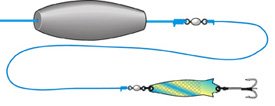
All you need is around 30m of 80lb to 100lb breaking strain nylon fishing line, a trolling sinker, a swivel and a suitable lure on a leader of lighter line (around 20lb or so), assembled as shown here.
The Uni-Knot is the one to use, both at the swivel and the lure connections.
Trolling Sinkers
Trolling sinkers can be either:~
- threaded on the line through a drilled hole, as with the barrel lead.
This type is free to slide down the line but stopped some distance short of the lure by a swivel.

- tied directly into the line at the appropriate point.
- wound into the line at the appropriate point, as with a spiral lead
These traditional trolling sinkers are asymmetric, a design which resists any tendency to spin and put twists in the line.
These can be positioned anywhere on your main line by wrapping the line
around it in the grooves, and locating it at each end within the wire
coil. The benefit of spiral leads is that they can be changed without
having to dismantle your gear.
Whichever type of trolling sinker you go for, don't fix it too close to the lure or it will spook the fish - the distance between them should be at least 3m (10 feet).

If your leader is shorter than this, then clearly if you're using a sliding barrel sinker, using the swivel to stop it isn't going to work.
In this case, use a matchstick, or a cocktail stick, to jam the line in the sinker to position the lead as far up the main line as you like.

For convenience and ease of deployment, stow the whole shebang on a plastic Yo-Yo.
Incidentally, don't be tempted to use the new generation, very low stretch, small diameter braid line as handlines as they can cut, even through gloves. These hi-tech lines should only be used for trolling with a high-spec rod and reel trolling outfit. Nylon monofilament line is fine for the job, and it's much cheaper too.
Trolling Lures for Mackerel
Any small silver or gold spinner or spoon that flashes brightly as it's drawn through the water will catch mackerel.

Apart from the ubiquitous mackerel spinner, you could try a Mepps spinner, a small Clarkes spoon, a Toby lure, a small Dexter Wedge or an Abu Krill - but there're lots more that will do the job.

Mackerel are normally found in shoals so with a multi-lured rig you're likely to pick up several at a time as you troll through the shoal.
If this prospect appeals to you, replace the single lure with a string of mackerel feathers - or better, small hokkai or similar lures - and tie on a small spinner at the end of the string.
Using a Reel
Rather than storing your handline on a yo-yo, you could instead use a fishing reel bolted securely to the stern rail. A size 4/0 or 6/0 multiplier reel, or a drum reel like one of the smaller Alvey reels would be ideal.
With a longer length of line now available to you, you can vary the distance aft of your lure as necessary, and you won't have to deal with a tangled mess of line in the cockpit when you retrieve your catch.
Another benefit is that you can set the clutch on the reel such that it's only just resisting the drag of the line. With the ratchet set to 'on' you'll know immediately when you've got a fish.
Getting Down Deeper
If the fish aren't being particularly obliging, it may be that they're hanging out further below the surface. If the trolling sinker isn't getting your lure down deep enough to reach them there are a number of things you can do - slow down, let out more line or use a heavier trolling sinker.
Or perhaps a better solution ...
Use a Plastic Paravane or a Stainless Steel Downrigger Planer!.
Trolling Lures for Bass
A small spinner or spoon will be fine for mackerel, but as mentioned earlier you may have to try a bit harder for bass. Here we're talking about the European Seabass - the much larger Striped Bass ('Stripers') on the other side of the Atlantic are a different kettle of fish altogether.

There are a large number of inshore trolling lures of different types that will do the job.
My choice would be ether a plug, a leadhead or an
artificial sandeel as illustrated here.
Whichever lure you use, troll it slowly - 2 to 3knots or so is about right - and on a long trace of at least 4m (13 feet).
This gear will be perfectly adequate for the fish you're likely to catch
by trolling on the Continental Shelf - primarily mackerel, garfish,
bass and pollack. But when sailboat cruising offshore you'll soon be off
soundings and be sharing the hunting grounds of the large pelagic
predators of the open ocean.
Maybe crossing Biscay on passage for Northern Spain, Cape St. Vincent and onwards to the Mediterranean? Perhaps the to Azores, Madeira, the Canaries, the Cape Verdes and an Atlantic crossing.
Now your inshore handline is woefully inadequate; you need to beef it up a bit for an offshore version.
A Trolling Handline for
Offshore Sailboat Cruising
For the sailor, whose crew isn't entirely made up entirely of vegetarians, this is the way to catch great tasting fish when sailboat cruising.

The main line itself will be about 35m (120 feet) of 300lb breaking strain nylon line.
It terminates at the boat end in a Flemish Eye (or a reinforced crimped loop) - for attaching the snubber - and will have a ball-bearing snap swivel at the other for attaching the leader.
The leader should be of 250lb nylon line and no less than 5m (16 foot) long. It too should be made up with a small Flemish Eye (or a reinforced crimped loop) - for attaching to the link swivel - and your lure will be attached to the other. In lines of this diameter, all connections will have to be crimped - you'll find it insufficiently flexible to tie reliable knots.
Click Here for everything you need to know about
Offshore Trolling Handlines
The Essential Snubber
As you're now more likely to hook up with much larger fish which would have the power to rip themselves free of the hook, a shock absorber (the snubber) needs to be built into the system.

This is effectively a large elastic band between the end of the handline and the boat. I favour using a loop of bungee cord, but surgical tubing can be used, as can an old cycle tyre inner tube.
Rigging it with a length of rope (I use 8mm braid-on-braid shock cord) as shown in the illustration serves two purposes:~
- It provides a safety loop if the bungee breaks. To minimise the risk of this happening, make sure that the loop tightens just before the bungee is stretched to breaking point. The other end is tied to a strong point on the boat.
- The snubber brings with it a side benefit - its constant stretching and relaxing adds life to the lure, causing it to dart around a little as would a live fish.
Also note the use of a heavy shock leader, which is there to withstand abrasion from the fish itself, and the boat when you get your catch close to the transom.
Usually a simple handline such as this will be fine for offshore sailboat cruising. Only when you find yourself with a very large fish on the end of it are you likely to have a problem - and it's mainly one of safety.
With the fish brought halfway to the cockpit you'll have coils of loose line in the cockpit. If the fish suddenly takes line again, (even if it's a small one, a larger one may grab it) and you're unfortunate enough to have your foot in a coil of it, you'll need to act fast. So always have a knife to hand.
Using a Reel
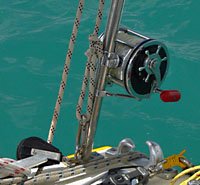
The last thing you need when sailboat cruising far offshore is any kind of accident. The way to avoid those dangerous coils is to use a large reel securely bolted to the taffrail.
These reels incorporate a slipping clutch and a ratchet, so with the clutch set (by turning the star drag) to give line when a fish hits the lure, a snubber is no longer required. And with the ratchet set to 'on' you'll be in no doubt as to when the action starts.
On 'Alacazam' we use a multiplier reel - a Penn Senator 12/0 loaded with 120lb nylon monofilament fishing line.
Trolling Lures for Sailboat Cruising Offshore
Predictably perhaps, trolling lures for offshore sailboat cruising - being for larger fish tend to be larger than those for inshore use.
There are four main types - skirted lures, spoons, plugs and soft plastic lures.
For offshore handlines I would recommend sticking with skirted lures, which are cheaper than the others types and consequently don't hurt the pocket so much when you lose one.
Trolling with a Rod and Reel
Of course if you're a 'proper' fisherman rather than just an sailboat cruising skipper after a free meal, you'll probably want to use a rod and reel for trolling. Now you'll be able to play the fish as it struggles to free itself, and will have far more control over it when you get it close to the boat.
But fishing rods and reels intended for offshore trolling require additional items of equipment - trolling rod holders, a butt pad and possibly a harness.
 Ready for the action to start on Alacazam
Ready for the action to start on Alacazam
A word of warning about harnesses - if you're wearing one of these and got your rod hooked up to it, you're directly connected to the fish.
If it pulls harder than you can and the reel jams, you'll find yourself sharing his environment - and in big trouble.
And just one thing about trolling rods - keep them short. Not just because it's a lever and you're on one end of it, but also for reasons of convenience.
If your sailboat is anything like mine you'll find yourself operating in a small rectangle bounded by the transom, the backstay and the gantry. Sometimes a multihull makes a lot of sense for sailboat cruising - and fishing!
Recent Articles
-
Sea Fishing Rods and Reels Must Be Compatible for a Balanced Outfit
Mar 08, 21 08:30 AM
A quality reel fitted to a quality rod doesn't necessarily make it a quality outfit. Your fishing rods and reels have to be properly matched if you're to get the best out of them, and here’s how -
Essential Lure Fishing Tips That All Saltwater Anglers Should Know
Mar 08, 21 04:51 AM
Which single lure fishing tip applies to trolling, jigging, baitcasting, spinning, fly fishing and any other branch of lure fishing? Well, it is the one at the top of this list -
Vital Jig Fishing Tips That You Really Cannot Afford To Miss!
Mar 07, 21 10:20 AM
Essential jig fishing tips to help you select the right lure for successful jig fishing, together with the techniques required to get the most out of your jig fishing outfit







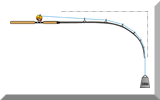



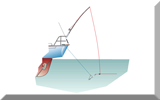





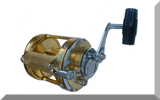


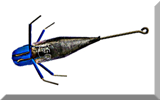



New! Comments
Have your say about what you've just read! Leave me a comment in the box below.